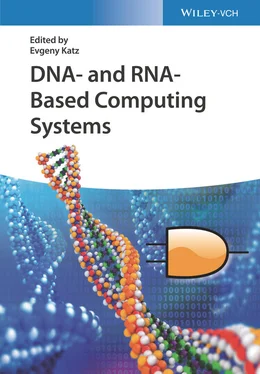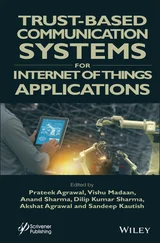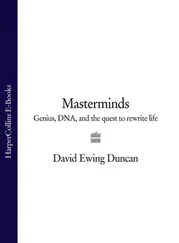6 6 Chiu, M.L., Goulet, D.R., Teplyakov, A., and Gilliland, G.L. (2019). Antibody structure and function: the basis for engineering therapeutics. Antibodies (Basel) 8 https://doi.org/10.3390/antib8040055.
7 7 Fernandez, L.A. and Muyldermans, S. (2011). Recent developments in engineering and delivery of protein and antibody therapeutics. Curr. Opin. Biotechnol. 22: 839–842. https://doi.org/10.1016/j.copbio.2011.08.001.
8 8 Michelotti, N., Johnson‐Buck, A., Manzo, A.J., and Walter, N.G. (2012). Beyond DNA origami: the unfolding prospects of nucleic acid nanotechnology. Wiley Interdiscip. Rev. Nanomed. Nanobiotechnol. 4: 139–152. https://doi.org/10.1002/wnan.170.
9 9 Zuker, M. (2003). Mfold web server for nucleic acid folding and hybridization prediction. Nucleic Acids Res. 31: 3406–3415. https://doi.org/10.1093/nar/gkg595.
10 10 Zadeh, J.N., Steenberg, C.D., Bois, J.S. et al. (2011). NUPACK: analysis and design of nucleic acid systems. J. Comput. Chem. 32: 170–173. https://doi.org/10.1002/jcc.21596.
11 11 Turner, D.H. (1996). Thermodynamics of base pairing. Curr. Opin. Struct. Biol. 6: 299–304. https://doi.org/10.1016/s0959-440x(96)80047-9.
12 12 Petersheim, M. and Turner, D.H. (1983). Base‐stacking and base‐pairing contributions to helix stability: thermodynamics of double‐helix formation with CCGG, CCGGp, CCGGAp, ACCGGp, CCGGUp, and ACCGGUp. Biochemistry 22: 256–263. https://doi.org/10.1021/bi00271a004.
13 13 Leontis, N.B., Stombaugh, J., and Westhof, E. (2002). The non‐Watson‐Crick base pairs and their associated isostericity matrices. Nucleic Acids Res. 30: 3497–3531. https://doi.org/10.1093/nar/gkf481.
14 14 Sweeney, B.A., Roy, P., and Leontis, N.B. (2015). An introduction to recurrent nucleotide interactions in RNA. Wiley Interdiscip. Rev.: RNA 6: 17–45. https://doi.org/10.1002/wrna.1258.
15 15 Leontis, N.B. and Westhof, E. (2002). The annotation of RNA motifs. Comp. Funct. Genomics 3: 518–524. https://doi.org/10.1002/cfg.213.
16 16 Seeman, N.C. (1982). Nucleic acid junctions and lattices. J. Theor. Biol. 99: 237–247. https://doi.org/10.1016/0022-5193(82)90002-9.
17 17 Chen, J.H. and Seeman, N.C. (1991). Synthesis from DNA of a molecule with the connectivity of a cube. Nature 350: 631–633. https://doi.org/10.1038/350631a0.
18 18 Pinheiro, A.V., Han, D., Shih, W.M., and Yan, H. (2011). Challenges and opportunities for structural DNA nanotechnology. Nat. Nanotechnol. 6: 763–772. https://doi.org/10.1038/nnano.2011.187.
19 19 Chen, T., Ren, L., Liu, X. et al. (2018). DNA nanotechnology for cancer diagnosis and therapy. Int. J. Mol. Sci. 19 https://doi.org/10.3390/ijms19061671.
20 20 Cox, A.J., Bengtson, H.N., Rohde, K.H., and Kolpashchikov, D.M. (2016). DNA nanotechnology for nucleic acid analysis: multifunctional molecular DNA machine for RNA detection. Chem. Commun. (Camb) 52: 14318–14321. https://doi.org/10.1039/c6cc06889h.
21 21 Afonin, K.A., Schultz, D., Jaeger, L. et al. (2015). Silver nanoclusters for RNA nanotechnology: steps towards visualization and tracking of RNA nanoparticle assemblies. Methods Mol. Biol. 1297: 59–66. https://doi.org/10.1007/978-1-4939-2562-9_4.
22 22 Bui, M.N., Brittany Johnson, M., Viard, M. et al. (2017). Versatile RNA tetra‐U helix linking motif as a toolkit for nucleic acid nanotechnology. Nanomedicine 13: 1137–1146. https://doi.org/10.1016/j.nano.2016.12.018.
23 23 Guo, P. (2010). The emerging field of RNA nanotechnology. Nat. Nanotechnol. 5: 833–842. https://doi.org/10.1038/nnano.2010.231.
24 24 Shukla, G.C., Haque, F., Tor, Y. et al. (2011). A boost for the emerging field of RNA nanotechnology. ACS Nano 5: 3405–3418. https://doi.org/10.1021/nn200989r.
25 25 Rothemund, P.W. (2006). Folding DNA to create nanoscale shapes and patterns. Nature 440: 297–302. https://doi.org/10.1038/nature04586.
26 26 Woo, S. and Rothemund, P.W. (2014). Self‐assembly of two‐dimensional DNA origami lattices using cation‐controlled surface diffusion. Nat. Commun. 5: 4889. https://doi.org/10.1038/ncomms5889.
27 27 Andersen, E.S., Dong, M., Nielsen, M.M. et al. (2008). DNA origami design of dolphin‐shaped structures with flexible tails. ACS Nano 2: 1213–1218. https://doi.org/10.1021/nn800215j.
28 28 Grabow, W.W. and Jaeger, L. (2014). RNA self‐assembly and RNA nanotechnology. Acc. Chem. Res. 47: 1871–1880. https://doi.org/10.1021/ar500076k.
29 29 Sparvath, S.L., Geary, C.W., and Andersen, E.S. (2017). Computer‐aided design of RNA origami structures. Methods Mol. Biol. 1500: 51–80. https://doi.org/10.1007/978-1-4939-6454-3_5.
30 30 Parlea, L.G., Sweeney, B.A., Hosseini‐Asanjan, M. et al. (2016). The RNA 3D Motif Atlas: computational methods for extraction, organization and evaluation of RNA motifs. Methods 103: 99–119. https://doi.org/10.1016/j.ymeth.2016.04.025.
31 31 Kaplan, W. and Littlejohn, T.G. (2001). Swiss‐PDB viewer (deep view). Briefings Bioinf. 2: 195–197. https://doi.org/10.1093/bib/2.2.195.
32 32 Jasinski, D., Haque, F., Binzel, D.W., and Guo, P. (2017). Advancement of the emerging field of RNA nanotechnology. ACS Nano 11: 1142–1164. https://doi.org/10.1021/acsnano.6b05737.
33 33 Shu, Y., Haque, F., Shu, D. et al. (2013). Fabrication of 14 different RNA nanoparticles for specific tumor targeting without accumulation in normal organs. RNA 19: 767–777. https://doi.org/10.1261/rna.037002.112.
34 34 Afonin, K.A., Bindewald, E., Kireeva, M., and Shapiro, B.A. (2015). Computational and experimental studies of reassociating RNA/DNA hybrids containing split functionalities. Methods Enzymol. 553: 313–334. https://doi.org/10.1016/bs.mie.2014.10.058.
35 35 Halman, J.R., Satterwhite, E., Roark, B. et al. (2017). Functionally‐interdependent shape‐switching nanoparticles with controllable properties. Nucleic Acids Res. 45: 2210–2220. https://doi.org/10.1093/nar/gkx008.
36 36 Hong, E., Halman, J.R., Shah, A.B. et al. (2018). Structure and composition define immunorecognition of nucleic acid nanoparticles. Nano Lett. 18: 4309–4321. https://doi.org/10.1021/acs.nanolett.8b01283.
37 37 Parlea, L., Bindewald, E., Sharan, R. et al. (2016). Ring catalog: a resource for designing self‐assembling RNA nanostructures. Methods 103: 128–137. https://doi.org/10.1016/j.ymeth.2016.04.016.
38 38 Jasinski, D.L., Khisamutdinov, E.F., Lyubchenko, Y.L., and Guo, P. (2014). Physicochemically tunable polyfunctionalized RNA square architecture with fluorogenic and ribozymatic properties. ACS Nano 8: 7620–7629. https://doi.org/10.1021/nn502160s.
39 39 Khisamutdinov, E.F., Jasinski, D.L., and Guo, P. (2014). RNA as a boiling‐resistant anionic polymer material to build robust structures with defined shape and stoichiometry. ACS Nano 8: 4771–4781. https://doi.org/10.1021/nn5006254.
40 40 Khisamutdinov, E.F., Jasinski, D.L., Li, H. et al. (2016). Fabrication of RNA 3D nanoprisms for loading and protection of small RNAs and model drugs. Adv. Mater. 28: 10079–10087. https://doi.org/10.1002/adma.201603180.
41 41 Guo, P., Haque, F., Hallahan, B. et al. (2012). Uniqueness, advantages, challenges, solutions, and perspectives in therapeutics applying RNA nanotechnology. Nucleic Acid Ther. 22: 226–245. https://doi.org/10.1089/nat.2012.0350.
42 42 Shu, D., Shu, Y., Haque, F. et al. (2011). Thermodynamically stable RNA three‐way junction for constructing multifunctional nanoparticles for delivery of therapeutics. Nat. Nanotechnol. 6: 658–667. https://doi.org/10.1038/nnano.2011.105.
43 43 Shu, D., Khisamutdinov, E.F., Zhang, L., and Guo, P.X. (2014). Programmable folding of fusion RNA in vivo and in vitro driven by pRNA 3WJ motif of phi29 DNA packaging motor. Nucleic Acids Res. 42 (Art. No.: e10) https://doi.org/10.1093/nar/gkt885.
44 44 Guet, D., Burns, L.T., Maji, S. et al. (2015). Combining Spinach‐tagged RNA and gene localization to image gene expression in live yeast. Nat. Commun. 6: 8882. https://doi.org/10.1038/ncomms9882.
Читать дальше












